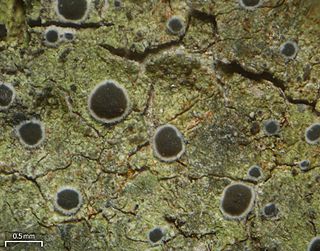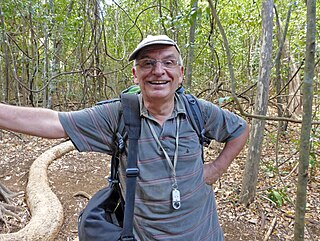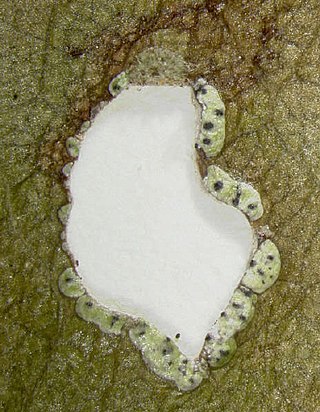
Porina is a genus of lichens in the family Trichotheliaceae. A 2020 estimate places about 145 species in the widespread genus.

Byssoloma is a genus of leaf-dwelling lichens in the family Pilocarpaceae.

Enterographa is a genus of lichens in the family Roccellaceae.

Lecanactis is a genus of crustose lichens, commonly called old wood rimmed lichen. The genus was circumscribed in 1855 by German lichenologist Gustav Wilhelm Körber, who assigned Lecanactis abietina as the type species.

Syncesia is a genus of lichen-forming fungi in the family Roccellaceae.
Caprettia is a genus of lichenized fungi in the family Monoblastiaceae. The genus was circumscribed by Augusto Chaves Batista and Heraldo da Silva Maia in 1965, with Caprettia amazonensis assigned as the type species.
Lyromma is a genus of foliicolous (leaf-dwelling) lichens, and the sole member of Lyrommataceae, a family in the order Chaetothyriales. The genus was circumscribed in 1965 by Brazilian mycologists Augusto Chaves Batista and Heraldo da Silva Maia, with Lyromma nectandrae assigned as the type species. The family was proposed by Robert Lücking in 2008. Characteristics of the genus include the spherical to short barrel-shaped perithecia and elongated barrel-shaped pycnidia, and smooth thalli of rounded patches formed by its symbiotic relationship with green algae from the genus Phycopeltis.
Calenia is a genus of lichen-forming fungi within the family Gomphillaceae.
Echinoplaca is a genus of lichens in the family Gomphillaceae.
Gyalectidium is a genus of lichen-forming fungi in the family Gomphillaceae. A 2020 estimates placed 52 species in the genus. The genus was circumscribed by Swiss lichenologist Johannes Müller Argoviensis in 1881. He included 3 species: G. xantholeucum, G. dispersum, and G. filicinum; the last of these is now the type species of the genus.
André Aptroot is a Dutch mycologist and lichenologist.

Malmideaceae is a family of crustose and corticolous lichens in the order Lecanorales. It contains eight genera and about 70 species.

Emmanuël Sérusiaux is a Belgian lichenologist. His career, spanning more than four decades, has combined both lichenology research and political aspects of nature conservation. He spent several periods working as a researcher at the National Fund for Scientific Research and the University of Liège, the latter in which he accepted a faculty position as professor and head of the Plant Taxonomy and Conservation Biology unit. Sérusiaux also served for three non-consecutive appointments as Deputy Chief of Staff in the Government of Wallonia. He retired from both his academic and political positions in 2019.

Strigulaceae is a family of lichen-forming fungi, one of two families in the order Strigulales. Recent (2020) molecular analysis of the type genus, Strigula, has led to a reallocation of the foliicolous species into six genera that correspond to well-delimited clades with diagnostic phenotype features.

Coenogonium is a genus of crustose lichens in the monotypic family Coenogoniaceae. It has about 90 species. Most species are leaf-dwelling or grow on bark, although a few are known to grow on rocks under certain conditions, and some are restricted to growth on termite nests. The genus was circumscribed in 1820 by German naturalist Christian Gottfried Ehrenberg.
Eugeniella is a genus of mostly leaf-dwelling (foliicolous) lichens in the family Pilocarpaceae. It contains 13 species. The genus was circumscribed in 2008 by lichenologists Robert Lücking, Emmanuël Sérusiaux, and Klaus Kalb, with Eugeniella psychotriae assigned as the type species. This lichen was originally called Patellaria psychotriae by Johannes Müller Argoviensis in 1881. The seven species that were initially included in the genus had previously been placed in the genera Bacidia and Byssoloma. Several newly identified species from Australasia and Central and South America were later added. Most of the species grow on leaves, although four of the Australasian species grow on bark.
Gyalectidium yahriae is an uncommon species of crustose lichen in the family Gomphillaceae. It occurs in Florida and Papua New Guinea, recorded growing on bark in the former location and on both bark and on wood in the latter.

Robert Lücking is a German lichenologist. He earned his master's and PhD from the University of Ulm, focusing on the taxonomy, ecology, and biodiversity of foliicolous lichens. He has received numerous awards for his work, including the Mason E. Hale award for his doctoral thesis, the Augustin Pyramus de Candolle prize for his monograph, and the Tuckerman Award twice for his publications in The Bryologist. Since 2015, he has been serving as the curator of lichens, fungi, and bryophytes at the Berlin Botanical Garden and Botanical Museum, and several lichen species and a genus have been named in his honour.
Dictyomeridium is a genus of corticolous (bark-dwelling), crustose lichens in the family Trypetheliaceae. It has eight species.
Aspidothelium lueckingii is a species of corticolous (bark-dwelling) in the family Thelenellaceae. Found in mountainous cloud forests in Bolivia, it was formally described in 2009 by lichenologist Adam Flakus. The type specimen was collected near Incachaca village at an elevation of 2,317 m (7,602 ft), where it was found growing on the bark of a pine tree. It is known only from the type locality. It is named in honour of German lichenologist Robert Lücking, "for his magnificent contribution to the knowledge of tropical lichens."









